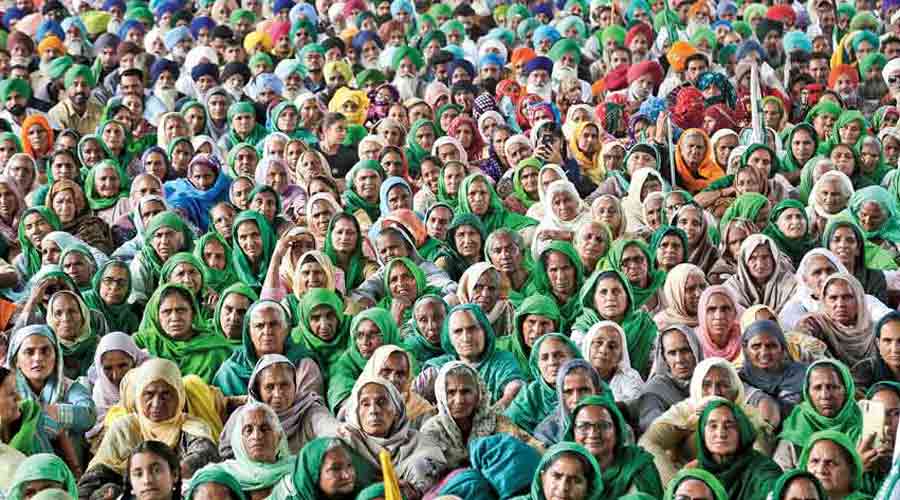
New angles The farmers’ protest exposed the limitations of class analysis
Don't Miss
Superficially, the farmers’ movement might look similar to that of the Jayaprakash Narayan-led movement of ‘total revolution’ or to the Anna Hazare-led ‘anti-corruption’ agitation. However, they miss the mark. ‘Total revolution’ reminds one of the French saying, ‘the more you try to embrace, the less you do.’ The anti-corruption movement was even hollower. It never made clear the difference between personal and systemic corruption. Consider that the three farm laws were made legal (however dubiously) but it does not negate the fact that they were meant to hollow out our democracy further by making the livelihood of half of India’s population dependent on the profit motive of two large private business houses. It is less relevant whether Prime Minister Narendra Modi is personally corrupt or not. His action was meant to further corrupt our democracy, and that matters more.
The farmers could rise above the blame game of party politics and the vicious narratives of false nationalism. Having forged a solidarity of caste and class and rejected the Manuvaad of gender domination, they now face the problem of negotiating their demand for minimum support price with the broader objectives of a society in which coexist many different interest groups.
Much of the discussion about providing a legal guarantee for MSP for agricultural produce of 23 crops in total (seven grains, five pulses, seven oilseeds and four cash crops) focused mostly on its role as an income support policy for farmers. This is, indeed, a priority in the backdrop of the distressed conditions of farmers which has been made all too apparent by the large number of farmers’ suicide each year, their mounting debts pointing to the unviability of a situation where the cost of cultivation often tends to exceed the selling price. The false promises made by the prime minister of doubling farmers’ income is a cruel joke.
If income support to farmers, especially to small farmers, materializes, it would have a tremendous positive impact on the external economy, raising demand for industry, especially small and medium scale industries, in the unorganized sector. The non-agricultural population stands to gain from it. Through a legal guarantee for MSP, steps need to be taken to make small farms viable and take the wider non-agricultural public along with it. A higher support price to raise farmers’ income might appear incompatible with the national food security policy implemented through an extended public distribution system. It had originated in measures for stabilizing prices of essential commodities against speculation in 1955 and for creating adequate storing facilities. The government now spends, on an average, about 3 lakh crore annually mostly for price stabilization through public distribution without an income support policy for farmers. An MSP can link price stabilization with income support.
The price of each of the 23 crops has to be set within a band. In general, lower price in good and higher price in bad harvest years may be set to limit speculation. Several coarse grains and pulses, which are climatically suited for low-rain-fed areas, may be set at the higher end of the band to induce change in the cropping pattern in the long run through relative price incentives.
The Swaminathan Committee’s recommendation as a benchmark for MSP will cost some 17 lakh crore, according to the government. This is certainly an overestimate. Taking into account non-traded self-consumption by farmers which is higher for coarse grains, some 45-50 per cent of the production is marketed surplus. The money recovered by sales through the PDS is a deduction from the total cost of MSP; another deduction is the stabilization of price through public distribution. Reckoning with all this, most estimates converge in the range of 5 to 7 lakh crore. Compare this with the dearness allowance and other benefits given to government employees (an estimated 5 per cent of the population) which is about 5 lakh crore; the tax breaks and revenue forgone to help a handful of big business, of about 4 lakh crore; the unofficial, reliable estimate of deliberate default of bank loans which is some 10 lakh crore for 28 borrowers whose names are known and, interestingly, all of them, except one, are from Gujarat. Does a sum of 5-7 lakh crore for an estimated 50 per cent of India’s population sound astronomical in view of these facts? Or is it simply because the farmers do not have a strong enough political voice?
These measures can only work through panchayats and gram sabhas that must have the required fiscal right and autonomy (which is already in the 73rd amendment of the Constitution), to be reviewed and revised every five years in the light of performance regarding parameters like yield, loan repayment, cropping pattern and, perhaps, also criteria like gender, caste and participation of religious minorities.
The farmers’ struggle organized through panchayats and mahapanchayats has been nearly miraculous. A constitutional provision for greater power to them for organizing their own economy already exists. They alone can do it.
(Amit Bhaduri taught Economics in various universities around the world)


0 Response to " New angles The farmers’ protest exposed the limitations of class analysis"
Post a Comment
Disclaimer Note:
The views expressed in the articles published here are solely those of the author and do not necessarily reflect the official policy, position, or perspective of Kalimpong News or KalimNews. Kalimpong News and KalimNews disclaim all liability for the published or posted articles, news, and information and assume no responsibility for the accuracy or validity of the content.
Kalimpong News is a non-profit online news platform managed by KalimNews and operated under the Kalimpong Press Club.
Comment Policy:
We encourage respectful and constructive discussions. Please ensure decency while commenting and register with your email ID to participate.
Note: only a member of this blog may post a comment.